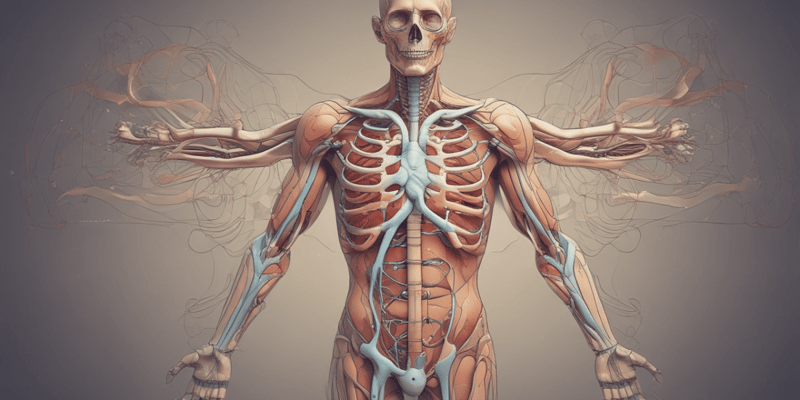37 Questions
What is the primary function of the epiglottis during eating?
To protect the esophagus
What is the name of the zone that includes all the airways from the nose to the terminal bronchi?
Conducting zone
What is the type of epithelium that lines the alveolar walls?
Simple squamous
What is the purpose of surfactants secreted by Type 2 alveolar cells?
To decrease the surface tension of alveolar fluid
What is the direction of blood flow in the pulmonary artery?
Deoxygenated blood from the heart to the lungs
What is the equation that summarizes the relationship between CO2, H2O, H+, and HCO3- in the blood?
CO2 + H2O <-> H+ + HCO3-
What is the primary function of the cartilages in the trachea?
To maintain the trachea's patency
What is the characteristic of the epithelium lining the respiratory bronchioles?
Ciliated pseudostratified
In which part of the respiratory system does the gas exchange occur?
Alveoli
What is the characteristic of the blood flow in the pulmonary artery?
Low pressure, high volume
What is the function of the hyaline cartilages in the trachea?
To maintain the trachea's patency
What is the purpose of the nasopharynx?
To warm and humidify the air
Which of the following processes is responsible for the exchange of oxygen and carbon dioxide between the lungs and the blood?
External respiration
What is the primary function of the respiratory system in relation to the circulatory system?
To supply the body with oxygen and dispose of carbon dioxide
Which of the following is NOT a part of the respiratory system?
Heart
What is the purpose of the four processes of respiration in the human body?
To supply the body with oxygen and dispose of carbon dioxide
Which of the following systems is responsible for transporting oxygen and carbon dioxide in the blood?
Circulatory system
What is the primary function of the pulmonary circulation?
Delivering systemic venous blood to the heart
What is the characteristic of the blood flow in the systemic circulation in the lungs?
High pressure, low volume
What is the function of the bronchial veins in the lungs?
Carrying most of the venous blood back to the heart
What is the relationship between the pulmonary arteries and the pulmonary veins?
Pulmonary arteries deliver deoxygenated blood, and pulmonary veins carry oxygenated blood
What is the difference between the pulmonary circulation and the systemic circulation in the lungs?
Pulmonary circulation has low pressure, while systemic circulation has high pressure
In the lungs, what is the primary reason for the partial pressure of oxygen reaching equilibrium of 104 mm Hg in approximately 0.25 seconds?
The steep partial pressure gradient of oxygen in the lungs
What is the main reason why carbon dioxide is transported more efficiently in the blood than oxygen?
Carbon dioxide is more soluble in water than oxygen
What is the primary mechanism by which oxygen is released from hemoglobin in the tissues?
Decrease in oxygen levels
What is the primary factor that influences the binding of oxygen to hemoglobin in the systemic circulation?
Blood pH
What is the primary function of the Bohr effect in the systemic circulation?
To decrease oxygen binding to hemoglobin
What is the primary stimulant of the respiratory center?
Rising CO2 levels
What is the name of the neurological component that integrates input from peripheral stretch and chemoreceptors?
Dorsal respiratory group (DRG)
What is the term for an increased ventilation rate of 10 to 20 fold in response to metabolic needs?
Hyperpnea
Which respiratory disorder is characterized by chronic bronchitis and emphysema?
Chronic obstructive pulmonary disease (COPD)
What is the total amount of air that can be moved in and out of the lungs, including the inspiratory reserve volume and the expiratory reserve volume?
6000 ml
What is the term for labored breathing or 'air hunger' in respiratory disorders?
Dyspnea
What is the volume of air that remains in the lungs after a normal exhalation, and is also known as the functional residual capacity?
2400 ml
What is the inspiratory capacity, which is the sum of the tidal volume and the inspiratory reserve volume?
3500 ml
What is the expiratory reserve volume, which is the amount of air that can be forcibly exhaled after a normal exhalation?
1200 ml
What is the tidal volume, which is the normal amount of air that is breathed in and out of the lungs at rest?
500 ml
Test your knowledge of the respiratory system's structure and functions, from the nasal passages to the trachea and esophagus. Learn about the roles of the epiglottis, hyaline cartilages, and ciliated epithelium in facilitating breathing and protecting the airway. Explore the relationships between the nasal cavity, pharynx, larynx, and esophagus.
Make Your Own Quizzes and Flashcards
Convert your notes into interactive study material.
Get started for free


